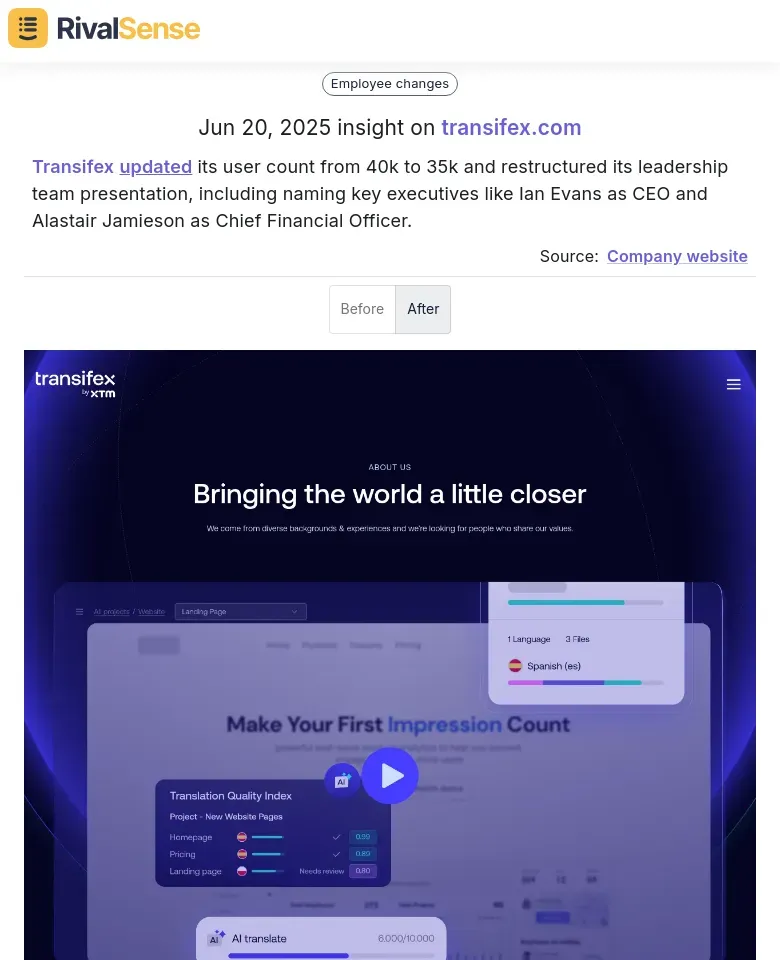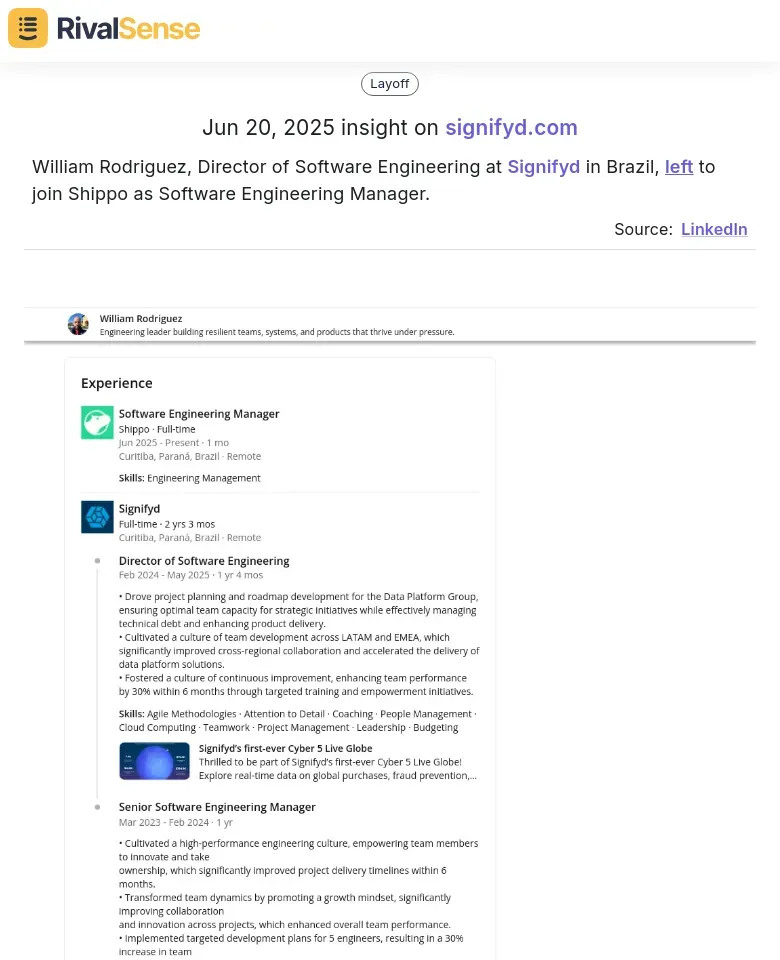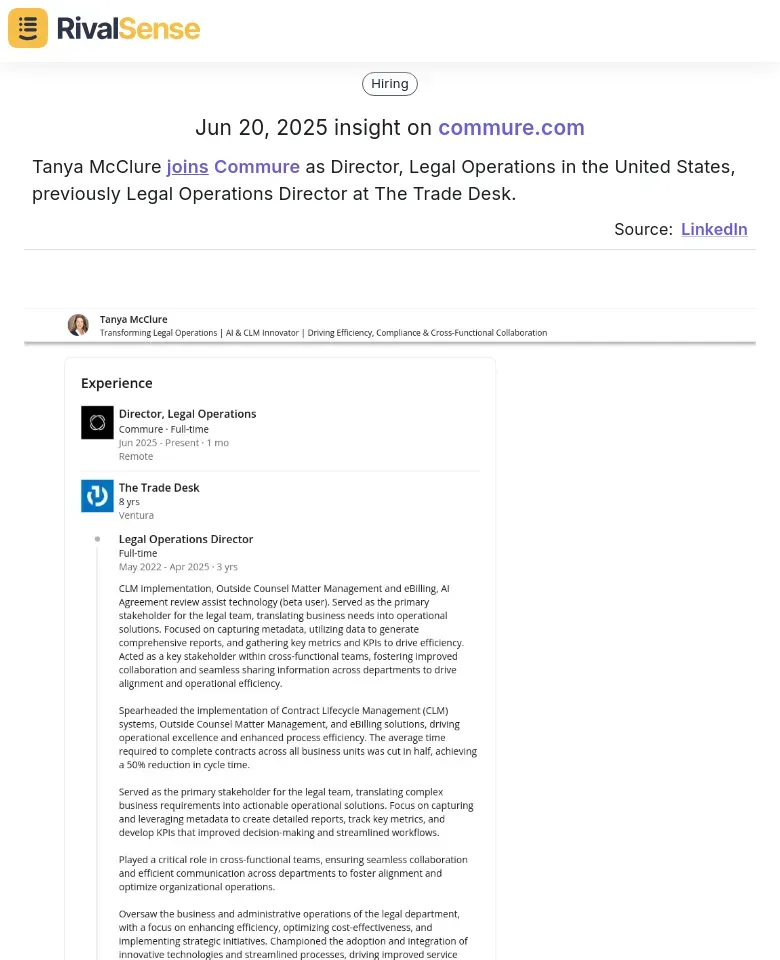Predict Competitor Moves: Decoding Employee Changes & Hiring Insights
Understanding workforce dynamics at rival companies unlocks strategic insights many overlook. Employee changes—hires, departures, and promotions—reveal shifts in priorities, emerging focus areas, or vulnerabilities. For instance, concentrated hiring in a specific department often precedes product launches, while leadership turnover signals internal challenges. These patterns provide early warnings about market shifts.
Key changes to monitor include:
- Executive Moves: C-suite shifts often indicate strategic pivots
- Departmental Hiring Spikes: Surges hint at new initiatives
- Notable Departures: Key talent loss may reveal operational issues
📋 Practical Steps to Leverage This Intelligence
- Set automated alerts for competitor job postings and LinkedIn updates
- Analyze hiring/departure trends against market movements
- Cross-reference with funding rounds or patent filings for context
Leadership Changes and What They Reveal
Executive reshuffles provide critical intelligence about a competitor's trajectory. A leadership overhaul often signals strategic redirection, while stability suggests confidence in current paths. The backgrounds of new appointees reveal priorities—like hiring a tech-focused CEO indicating digital transformation.
For example, RivalSense detected that Transifex updated its user count from 40k to 35k while restructuring leadership, naming Ian Evans as CEO and Alastair Jamieson as CFO:

Tracking such changes helps anticipate pivots—like whether reduced user counts might prompt new market strategies under fresh leadership.
✅ Action Plan:
- [ ] Monitor press releases and LinkedIn for announcements
- [ ] Research new executives' career histories
- [ ] Compare leadership changes across industry peers
- [ ] Align findings with your strategic planning
Key Departures and Their Implications
High-profile exits often indicate deeper organizational shifts—from strategic disagreements to internal challenges. Losing critical talent creates operational gaps, slows innovation, and impacts morale. Tracking these moves helps identify competitor vulnerabilities you can leverage.
Consider William Rodriguez leaving Signifyd as Director of Software Engineering to join Shippo:

Such departures reveal talent migration patterns between competitors, highlighting where expertise is valued—and potentially signaling strategic weaknesses in the losing organization.
🔍 Practical Analysis Framework:
| Departure Level | Strategic Implication |
|---|---|
| C-suite | Broad organizational impact |
| Mid-management | Departmental instability |
| Specialized roles | Skill gap vulnerabilities |
- Track exits via LinkedIn and industry news
- Identify patterns (e.g., multiple R&D departures)
- Assess role criticality to operations
- Engage alumni networks for insights
Strategic Hiring Insights
New hires act as advance signals for unannounced initiatives. Leadership appointments reveal strategic priorities—like a CFO with IPO experience hinting at fundraising plans. Departmental hiring spikes expose emerging focuses before public announcements.
RivalSense captured Tanya McClure joining Commure as Director of Legal Operations after leading similar functions at The Trade Desk:

Such moves highlight competitive investment areas—here, strengthening legal operations for compliance-heavy industries like healthcare tech.
📌 Decoding Hiring Patterns:
- AI/tech specialists → New product development
- International roles → Geographic expansion
- Regulatory experts → Compliance-focused growth
▶️ Execute this checklist monthly:
- [ ] Audit competitor job postings
- [ ] Map new hires' previous employers/skills
- [ ] Correlate with patent filings or funding news
Leveraging Employee Data for Competitive Advantage
Real-time employee intelligence transforms reactive strategies into proactive market positioning. By systematically tracking workforce movements, you detect strategic shifts 6-12 months before public announcements. This foresight allows preemptive countermeasures—like accelerating your own product development when rivals hire domain experts.
Real-World Impact Examples:
- A SaaS company spotted a competitor's AI hiring surge, fast-tracking their ML features to retain market share
- A retailer tracked rival layoffs in physical stores, reallocating budgets to e-commerce before the market shift
⚙️ Implementation Blueprint:
- Identify 3-5 critical competitors and their key personnel
- Automate monitoring via specialized tools
- Analyze trends quarterly for strategic alignment
- Integrate findings into leadership briefings
Conclusion and Next Steps
Employee tracking provides unparalleled visibility into competitor strategies, turning workforce movements into actionable intelligence. Consistent monitoring of hires, departures, and promotions helps anticipate market shifts, identify vulnerabilities, and capitalize on opportunities before rivals gain momentum. These insights become strategic leverage when integrated into your planning cycles.
Immediate Action Plan:
- Prioritize competitors with overlapping target markets
- Establish automated tracking for key personnel changes
- Schedule monthly intelligence reviews with leadership teams
🚀 Ready to decode competitor strategies?
Get your first automated competitor report today with RivalSense. Track leadership changes, hiring spikes, and departures across all key rivals—delivered in actionable weekly insights. No credit card required.
📚 Read more
👉 Turning Competitor Events into Strategic Opportunities
👉 Practical Approaches to Competitive Analysis: A Step-by-Step Guide
👉 Competitor Intelligence in AR/VR Training: Tracking Strategic Moves Beyond Press Releases
👉 How IPRoyal's Pricing Shift Spurred Competitor Strategy
👉 Strategic Competitor Insights: Internet-Based Comparative Analysis
